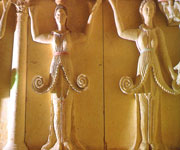The discovery in 1982 of the Thracian tomb of Sveshtari was one of the most spectacular archaeological events of the 20th century. The tomb itself is a unique artistic achievement with its half-human, half-vegetable caryatids enclosed in chitons in the shape of inverted palmettes. The fact the original polychromy has been preserved with its ochre, brown, blue, red and lilac shades adds to the bewitching charm of an expressive composition where the anthropomorphic supports conjure up the image of a choir of mourners frozen in the abstract positions of a ritual dance. The tomb is an exceptional testimony to the culture of the Getae, a Thracian people living in the north of Hemus, in contact with the Greek and Hyperborean worlds according to ancient geographers.
Continent: Europe
Country: Bulgaria
Category: Cultural
Criterion: (I)(III)
Date of Inscription: 1985
Thracian Tomb2
The tomb is located in a region declared an archaeological reserve, near the town of Razgra between the villages of Malak Porovetz and Sveshtari in Isperih municipality, in the river Krapinetz canyon and on the hills around. The time when the Sveshtari tomb was built (mid-3rd century BC) coincided with the period of a great political, economic and cultural upsurge of the Thracian tribe of the Getae. The rich decoration and perfect architecture of the tomb demonstrate the political power of the ruler.
Under a tumulus 11.5 m high and roughly 70 m in diameter, geophysical prospecting revealed, to the south-east, the monumental entrance to a hypogeum of exceptional interest, including a dromos, an antechamber, and two rectangular funeral chambers. The layout of this Thracian king's tomb, which is very different from that of Thracian tombs with cupolas such as that of Kazanlak, fits a Hellenistic model to be found in Macedonia, Asia Minor and Egypt. The tomb of Sveshtari is, however, unique in its architectural decor and in the specific character of funeral rites revealed by the excavation.
 |
| Thracian Tomb of Sveshtari Bulgaria |
Browse Gallery Plus UNESCO Storyline
The tomb consists of a corridor (dromos) and three square chambers: antechamber, lateral chamber, and main burial chamber covered by a semi-cylindrical vault. The plan of the building provides a new interesting example in Thracian building practice. The decoration of the tomb is executed in the spirit of the contemporary Hellenistic architecture. Its entrance is flanked by two rectangular columns (antae). Above them there is an architrave plate with a frieze in relief, consisting of stylized bovine heads (bucrania), rosettes and garlands. Ten beautiful female figures with hands raised high like caryatids are impressive. The figures are about 1.20 m tall, presented frontally, wearing long sleeveless dresses (chitons) tied with a thin belt below the breasts.
Two funerary beds, human bones and grave offerings were discovered in the central chamber. From the scattered stone details it was possible to reconstruct the facade of the tomb (aedicula), consisting of pilasters, cornice and a pediment, and closed with three stone doors. Being situated in front of the large funerary bed as a symbol of the boundary between life and death, the aedicula isolated the grave of the deified ruler (the most sacral part of the tomb) from the rest of the place. In the centre of the composition the goddess is offering a gold wreath to the ruler, depicted as a horseman facing her. On both sides of them there are processions of servants and armour-bearers carrying different gifts in their hands.
The layout of the central chamber which contained two stone funeral beds and an aedicula imitates the arrangement of a peristyle house: five half-columns and ten sculpted feminine caryatids in high relief on limestone flagstones support the architrave barrel-vaulted Doric frieze with its triglyphs and metopes spanning the room at mid-height.
In the north-west lunette, on the wall opposite the entrance, there is a painting depicting the deceased as hero, who, in the presence of several protagonists, is advancing on horseback towards the central figure of a deity extending a laurel wreath. Skeletal material found during excavation bears witness to the horse sacrifices that accompanied the funerary rites.
Browse All UNESCO World Heritage Sites in
Bulgaria. The original UNESCO inscription
Here!!!




